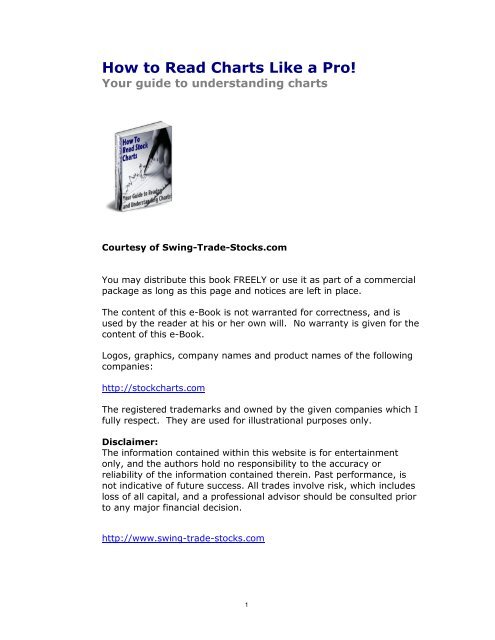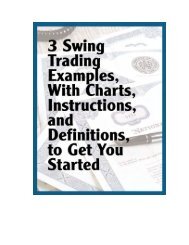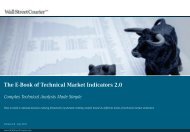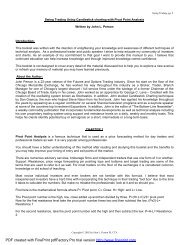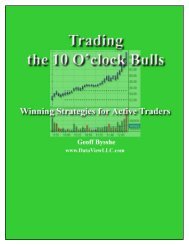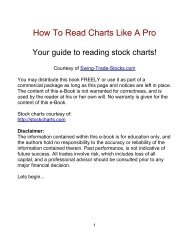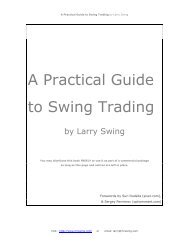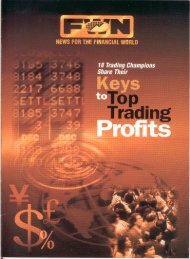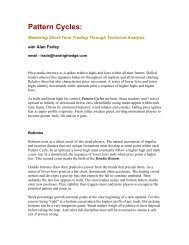How To Read Charts Like A Pro! - The Swing Trading Guide
How To Read Charts Like A Pro! - The Swing Trading Guide
How To Read Charts Like A Pro! - The Swing Trading Guide
Create successful ePaper yourself
Turn your PDF publications into a flip-book with our unique Google optimized e-Paper software.
<strong>How</strong> to <strong>Read</strong> <strong>Charts</strong> <strong>Like</strong> a <strong>Pro</strong>!<br />
Your guide to understanding charts<br />
Courtesy of <strong>Swing</strong>-Trade-Stocks.com<br />
You may distribute this book FREELY or use it as part of a commercial<br />
package as long as this page and notices are left in place.<br />
<strong>The</strong> content of this e-Book is not warranted for correctness, and is<br />
used by the reader at his or her own will. No warranty is given for the<br />
content of this e-Book.<br />
Logos, graphics, company names and product names of the following<br />
companies:<br />
http://stockcharts.com<br />
<strong>The</strong> registered trademarks and owned by the given companies which I<br />
fully respect. <strong>The</strong>y are used for illustrational purposes only.<br />
Disclaimer:<br />
<strong>The</strong> information contained within this website is for entertainment<br />
only, and the authors hold no responsibility to the accuracy or<br />
reliability of the information contained therein. Past performance, is<br />
not indicative of future success. All trades involve risk, which includes<br />
loss of all capital, and a professional advisor should be consulted prior<br />
to any major financial decision.<br />
http://www.swing-trade-stocks.com<br />
1
<strong>How</strong> to <strong>Read</strong> Stock <strong>Charts</strong><br />
Introduction<br />
Make no mistake about it. <strong>Read</strong>ing charts is an art form that can be<br />
mastered! <strong>The</strong>re are many factors on a chart that go into making<br />
trade decisions. You have to be able to analyze all of these factors<br />
and come to a conclusion about whether or not to risk your hard<br />
earned money on a trade. This is what separates the novice trader<br />
from the professional.<br />
<strong>The</strong>re are several things on a chart that make it worthy of<br />
trading. <strong>The</strong> questions that you want to ask yourself about the<br />
chart are:<br />
What stage is this stock in<br />
Is this stock in and uptrend or a downtrend<br />
Is the stock at the beginning, middle, or end of the trend<br />
<strong>How</strong> strong is the trend<br />
Where are the trend lines<br />
What wave is this stock in<br />
What do the moving averages tell me<br />
Was there a breakout recently<br />
Is the chart "smooth" or "sloppy"<br />
Are there any chart patterns<br />
Are there wide range candles in the direction of the trend<br />
Are there any gaps in the direction of the trend<br />
Are professionals selling strength or buying weakness<br />
Where are the support and resistance areas<br />
Is this stock at a Fibonacci level<br />
What does volume tell me<br />
2
I know it seems like a lot of information to try and keep track of but all<br />
of the above questions are essential to chart reading mastery! Now,<br />
print out that page of questions and keep it handy next to your<br />
computer. Make several copies so that you can check off and make<br />
notes as you analyze your next chart. Go ahead, I'll wait…<br />
Got it printed out Great! Now you won't forget anything important<br />
when it's time to analyze a chart for your next trade. In the heat of<br />
battle, when emotions are running high, it is very easy to forget to<br />
look for some of the most basic things on a chart. I've done it. That<br />
is, until I made this list!<br />
Ok, now let's go through the list one by one to make sure that you<br />
know how to answer the questions correctly. Don't worry, with<br />
practice, you will not even need to think about these things.<br />
It will become automatic.<br />
You will be able to read charts with lightning fast speed.<br />
In just a couple of seconds you will be able to glance at a chart and<br />
know all the answers to the questions above.<br />
Don’t believe me<br />
Just wait…<br />
3
Stages, Trends, and Waves<br />
Direction<br />
Ok, let's looks at an example chart…<br />
Nice chart! This stock broke out through a consolidation in July and<br />
now it is in a nice strong trend. <strong>The</strong> green arrow is the day on which<br />
we see this stock. So, what questions can we answer just from<br />
glancing at this chart<br />
This stock is in stage two<br />
You remember the stages right Stage one is a consolidation, stage<br />
two is an uptrend, stage three is another consolidation, and stage four<br />
is a downtrend. This stock was in a stage one in July but at the end of<br />
July, it broke out into a stage two. It is currently still in a stage two.<br />
This stock is in an uptrend<br />
This is the easy part. If a stock is heading toward the upper right<br />
corner of a chart then it is in an uptrend! For some reason, this tends<br />
to elude some traders.<br />
This stock is near the middle or end of the trend<br />
4
<strong>How</strong> do we know that <strong>The</strong> breakout signals the start of the trend.<br />
<strong>The</strong>re has already been one significant pullback. Had we bought stock<br />
on the first pullback, then we would have concluded that we are at the<br />
beginning of the trend. But since this is the second pullback, then we<br />
know that this trend may not last much longer.<br />
This stock is in a strong trend<br />
<strong>The</strong> ADX indicator (not shown) is near 30 which we consider to be a<br />
fairly strong trend. <strong>The</strong> higher the ADX, the stronger the trend.<br />
This stock is at the lower trend line<br />
You can see by the thick green line that this stock has hit the lower<br />
trend line. You can draw the trendlines in manually, but after you<br />
have been trading for awhile, you will not need to draw them. You will<br />
be able to see them automatically.<br />
This stock is in the fourth wave<br />
In Elliott Wave theory, a stock goes through 5 waves in an uptrend. In<br />
the chart above, the first wave after the breakout is wave 1. <strong>The</strong> first<br />
pullback is wave two, the next wave up to $69.00 is wave three, and<br />
the pullback that we are in now is wave four. <strong>The</strong>re is one more wave<br />
to go!<br />
Conclusion<br />
Now we have identified that the possible future direction of this stock<br />
is up. Nothing is ever certain in the stock market! <strong>How</strong>ever, by<br />
looking at this chart we can be certain that the probabilities are on our<br />
side for a continued move to the upside.<br />
After you finish reading this book, go through some charts and try to<br />
identify the various factors mentioned above. Just understanding the<br />
nature of stocks and the different stages, trends and waves that all<br />
stocks go through will greatly improve you trading.<br />
Soon, all of this direction analysis will become second nature. You<br />
won't even have to think about it.<br />
Were not done yet! Go on to the next chapter…<br />
5
Chart Analysis<br />
Price<br />
Price, as interpreted by candles, is the most important factor to<br />
consider on a chart. Put away the technical indicators. You do not<br />
need them. Technical indicators serve one purpose – to confuse<br />
novice traders! <strong>The</strong>re isn't anything on a chart that can be learned<br />
from them. Everything you need to know is right in front of you in the<br />
candles!<br />
Ok, let's go back to our chart example:<br />
<strong>The</strong>re are some very significant things happening on this chart. Do<br />
you see them You will in a minute.<br />
We continue answering questions…<br />
<strong>The</strong> moving averages are lined up<br />
We want the 10 SMA above the 30 EMA and we also want there to be<br />
plenty of space in between the two moving averages. This creates the<br />
Traders Action Zone (TAZ) that we can trade in. If the moving<br />
averages move too close together, then a trading range or basing<br />
pattern will likely develop. We don't want that!<br />
<strong>The</strong>re was a breakout recently.<br />
6
This is good! We want to buy a pullback as close as possible to a<br />
breakout as we can. Why We want to know that there is interest in a<br />
stock. Remember that institutional traders have to accumulate shares<br />
over time. <strong>The</strong>y can't buy tons of shares all at once. <strong>The</strong>y have to<br />
buy a little at a time. By looking for breakouts, we can expect them to<br />
have to buy more in the future. This will propel the stock higher.<br />
This is a smooth chart<br />
We don't want to trade stocks that are whipping around everywhere!<br />
That is a good way to get stopped out on trades. This stock is in a<br />
smooth uptrend that can be traded with confidence, and without fear<br />
of getting shaken out of the trade.<br />
No significant chart patterns<br />
In this example, there aren't any significant chart patterns. This is<br />
fine. You don't need any kind of a chart pattern like a cup and handle<br />
pattern, or a triangle to trade a stock. You do, however, want to be<br />
able to identify them when they are there. This could add some<br />
weight to the setup and may make us favor one trade over another.<br />
<strong>The</strong>re are wide range candles in the direction of the trend<br />
See how at the end of August there are three wide range candles that<br />
close near the top of their range <strong>The</strong>re was also a wide range candle<br />
on the breakout in July. This is very significant! In fact it may be one<br />
of the most significant things on the chart. Stocks tend to move in the<br />
direction of wide range candles.<br />
<strong>The</strong>re is one significant gap<br />
<strong>The</strong>re is only one significant gap to the upside on the breakout in July.<br />
Ideally, we would like to see more. A better case scenario would be if<br />
there was a more recent gap. Why Because stocks tend to move in<br />
the direction of gaps! Be careful though. After three or more gaps, a<br />
stock can become overbought and may not continue to move forward.<br />
<strong>Pro</strong>fessionals are buying weakness<br />
<strong>How</strong> do we know this We know by looking for "tails" or "shadows" at<br />
the bottom of the candles. On the sixth of September there is a tail,<br />
and on this day (green arrow) there is a tail. This is very significant!<br />
You want to see that the big players are coming in to support the<br />
stock. You want them to protect you from any downside risk.<br />
7
This stock is at support<br />
This stock has pulled back to a prior high made in the middle of<br />
August. This is identified by the red/green support line drawn on the<br />
chart. When a stock pulls back to a prior high it is known as minor<br />
support. It is still a significant support area, just not as significant as<br />
if it pulled back to a prior low. For example, if the stock pulled back to<br />
the prior low at $63.00 (see chart), then it would be major support.<br />
Also, notice how the lower trend line and the support line converge<br />
into one right at today's candle (green arrow). This is very significant!<br />
This increases the strength of the support.<br />
This stock is at a Fibonacci retracement level<br />
<strong>The</strong>re are three fibonacci retracement levels that you look at: 38.2%,<br />
50%, and 61.8%. This stock has pulled back to the 38.2% level (not<br />
shown on the chart above). You want to trade pullbacks to this level<br />
or the 50% level. If it goes down to the 61.8% level, it may be<br />
signaling weakness. Avoid those stocks. Note that this level also<br />
corresponds with the support line.<br />
Volume is showing that there interest in the stock<br />
See the big volume on up days and the lower volume on down days<br />
This is the ideal scenario but it isn't absolutely necessary. I tend to<br />
favor low volume pullbacks over high volume pullbacks but I will trade<br />
both. If a stock is pulling back on low volume, it means that traders<br />
have lost interest in the stock and things get really quiet. This is<br />
usually when institutional traders come in – when everyone forgets<br />
about the stock!<br />
Conclusion<br />
This concludes our analysis of the stock. We have determined that we<br />
are going to trade this stock!<br />
Want to see what happens next<br />
Go on to the next chapter…<br />
8
Conclusion<br />
Success!<br />
Here is the finished chart:<br />
Nice! All of our analysis has paid off. This stock has successfully<br />
moved in our favor and now we can just trail our stops under the lows<br />
of the candles until stopped out.<br />
I know it seems like a lot of work went into analyzing this chart but<br />
what can I say – trading stocks does take some work! It does,<br />
however, get faster. After you look at thousands and thousands of<br />
charts in this manner, everything will become second nature.<br />
Instead of it taking minutes to look at a chart it will take seconds.<br />
I hope you have enjoyed reading this little e-Book. More importantly,<br />
I hope that you can use this information and profit from it! After all,<br />
that is the goal – to make consistent profits in the stock market.<br />
Please take the time to give me your feedback. You can send your<br />
comments and suggestions on this page:<br />
http://www.swing-trade-stocks.com/contact.html<br />
Trade Well,<br />
Craig<br />
9
Additional Resources<br />
Websites<br />
At swing-trade-stocks.com…<br />
Market Stages<br />
http://www.swing-trade-stocks.com/stock-market-stages.html<br />
Stock Trends<br />
http://www.swing-trade-stocks.com/stock-trends.html<br />
Elliott Wave<br />
http://www.swing-trade-stocks.com/elliott-wave.html<br />
Adx Indicator<br />
http://www.swing-trade-stocks.com/ADX-indicator.html<br />
Other sites…<br />
Elliott Wave<br />
For more information on wave theory visit Elliott Wave International.<br />
<strong>The</strong>re is no better site on the net for learning about elliott wave. You<br />
can take the FREE tutorial on the trading the waves!<br />
Trade Trakker<br />
Need an inexpensive software solution to manage your trades Try<br />
out this program. I also have a review of this software on swingtrade-stocks.com<br />
InvestorFLIX<br />
One of the best learning tools on the net! Get stock market DVDs and<br />
CDs delivered right to your doorstep!<br />
Site Build It!<br />
Thinking about building your own website This is the company that I<br />
use<br />
10


